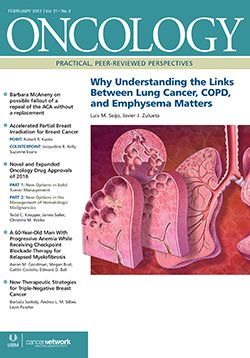Accelerated Partial Breast Irradiation for Breast Cancer: Not Ready for Routine Use
We know that breast cancer represents a spectrum of diseases, with variation in prognosis, and that RT can range from highly complex treatments to the breast and regional lymph nodes, to complete avoidance of radiation.
Oncology (Williston Park). 31(2):104,108-109, 128.

Jacqueline R. Kelly, MD, MSc

Suzanne Evans, MD, MPH

Accelerated partial breast irradiation (APBI) should not be used routinely in the treatment of breast cancer. Whole-breast irradiation (WBI) has an established local control benefit,[1] which has been shown to confer a survival benefit not only in invasive cancer,[2] but also in a subset of patients with ductal carcinoma in situ.[3] Breast cancer recurrence increases linearly with time, and both radiotherapy (RT) and systemic therapy continue to reduce local failure beyond 5 years after diagnosis. Therefore, robust follow-up data are needed before the routine use of any therapy that may compromise local control and subsequently survival.
APBI is not expected to provide better local control than WBI, so its use should be considered only if it might offer some other tangible benefit to women. Proponents of APBI cite the increased convenience of this technique, the promise of lower toxicity, and the hope that this technique will allow more women to receive radiation.[4] Currently, breast-conserving surgery (BCS) rates nationally are only 46% in seemingly eligible women,[5] and APBI has been proposed as a modality that may increase the use of BCS. To address this issue thoroughly, we will explore the validity of the claims of efficacy, convenience, toxicity, and access surrounding APBI.
Efficacy
Early practice of APBI had unacceptably high local recurrence rates.[6,7] These trials included patients with node-positive disease and larger tumors, no uniform clinical target volume margin, variable radiation techniques, and suboptimal methods of tumor bed localization that undoubtedly contributed to the observed high rates of failure. More recently, APBI has demonstrated much more favorable results. Despite promising prospective studies of highly selected patients,[8,9] randomized trials with adequate follow-up are lacking. The populations included in the current randomized trials have tumors that are predominantly estrogen receptor (ER)-positive[10] and luminal A subtype.[11] The natural history of these tumors is indolent, and they remain under the effect of endocrine therapy,[12] which makes the present follow-up inadequate to determine long-term efficacy.
Routine use of APBI would require that it could be applied to a broad population. Not only is the long-term efficacy of APBI uncertain, but there are also concerning data that suggest that local failure rates are high in women with ER-negative disease and other biologically adverse subtypes when a partial breast approach is used.[13,14] Therefore, a partial breast approach is not reasonable for routine use, but only for highly selected postmenopausal women with small tumors and no adverse pathologic features.[15]
Convenience
APBI is convenient. However, hypofractionated (HF) WBI is also a convenient option. With a treatment course of 15 fractions rather than 10, the UK Standardisation of Breast Radiotherapy (START) and Canadian phase III randomized trials have shown equivalent local control and reduced adverse effects with HF-WBI when compared with conventional fractionation (CF) WBI with long-term follow-up.[16,17] A randomized trial of HF- vs CF-WBI demonstrated significantly lower rates of acute grade 2 or higher toxicity and improved physical well-being and fatigue in the HF arm.[18] Rates of pneumonitis remain extremely low[19]; cardiac doses are modest, with minimal impact on outcomes[20-22]; and cosmesis is excellent with modern techniques.[23]
In an effort to further expedite treatment, the UK FAST-Forward trial, which is testing two 5-fraction regimens over 1 week vs HF-WBI, was launched at the end of 2011.[24] If the 1-week regimen is found to be noninferior to HF-WBI, it may eliminate the convenience advantage of APBI.
Toxicity
Although the convenience of APBI may be enticing, there are troubling toxicity reports in the APBI literature. Cosmetic results of the external beam technique have been reported to be inferior,[25-27] although this has not been uniformly found.[28,29] While the multicatheter-based interstitial brachytherapy literature has not echoed these findings, there are equipment and skill needs that prevent routine use of this technique.[30] Balloon-based brachytherapy is also associated with significant toxicity to the chest wall, as well as softtissue necrosis.[31,32] Although the exact reasons for mastectomy in this setting are not clear, women who receive APBI with balloon-based brachytherapy have double the rate of mastectomy, as well as a higher risk of breast pain, fat necrosis, rib fracture, and postoperative complications, compared with women who receive WBI.[33] Based on these data, the allegation that APBI always results in less toxicity than WBI is inaccurate.
Access
No data support the notion that partial breast irradiation will allow more eligible women to undergo BCS. In fact, the available data conflict with this hypothesis. The rate of mastectomy rose by 36% from 2005 to 2013,[34] despite an increase in the use of APBI from 8% in 2005 to 17% in 2008.[35] Although access is a cited reason for promoting APBI, rural living areas were independently associated with less utilization of APBI.[35] The reasons behind women’s selection of mastectomy are complex, and various factors influence their decision, including the use of MRI,[36] physician advice, and fear of future recurrence. Other initiatives have found that clinician education can increase rates of BCS[37]; however, to date APBI has not been shown to increase utilization of BCS or radiation following BCS.[38]
Conclusion
We know that breast cancer represents a spectrum of diseases, with variation in prognosis, and that RT can range from highly complex treatments to the breast and regional lymph nodes, to complete avoidance of radiation. The challenge will be to select the most appropriate treatment for the individual patient and to personalize RT based on tumor biology.[39]
The standard treatment for breast cancer patients at low risk for recurrence is conservative surgery followed by WBI. The APBI concept, developed more than 20 years ago, may be an option in carefully selected patients. However, the ideal patient profile for APBI is still not clearly identified, as evidenced by the heterogeneity of the inclusion criteria of the continuing APBI trials. The ongoing French SHARE trial will randomize 2,800 patients to three arms: APBI using three-dimensional conformal RT (1 week), CF-WBI (6.5 weeks), and HF-WBI (3 weeks).[40] Results of this trial should give us more insight into the optimal therapy for women with early-stage breast cancer.
Until long-term follow-up data are available, APBI should be used with caution in selected patients at low risk for ipsilateral breast tumor recurrence only, after careful informed consent is obtained. HF-WBI is a clinically proven alternative to APBI and CF-WBI for women who desire a shorter course of RT without potentially compromising local control and survival.
Financial Disclosure:The authors have no significant interest in or other relationship with the manufacturer of any product or provider of any service mentioned in this article. For the sake of transparency, it should be noted that Dr. Evans’s institution receives funding from 21st Century Oncology for research in which she is involved.
References:
1. Darby S, McGale P, Correa C, et al. Effect of radiotherapy after breast-conserving surgery on 10-year recurrence and 15-year breast cancer death: meta-analysis of individual patient data for 10 801 women in 17 randomised trials. Lancet. 2011;378:1707-16.
2. Clarke M, Collins R, Darby S, et al; Early Breast Cancer Trialists’ Collaborative Group. Effects of radiotherapy and of differences in the extent of surgery for early breast cancer on local recurrence and 15-year survival: an overview of the randomised trials. Lancet. 2005;366:2087-106.
3. Sagara Y, Freedman RA, Vaz-Luis I, et al. Patient prognostic score and associations with survival improvement offered by radiotherapy after breast-conserving surgery for ductal carcinoma in situ: a population-based longitudinal cohort study. J Clin Oncol. 2016;34:1190-6.
4. Wallner P, Arthur D, Bartelink H, et al. Workshop on Partial Breast Irradiation: State of the Art and the Science, Bethesda, MD, December 8–10, 2002. J Natl Cancer Inst. 2004;96:175-84.
5. Morrow M, White J, Moughan J, et al. Factors predicting the use of breast-conserving therapy in stage I and II breast carcinoma. J Clin Oncol. 2001;19:2254-62.
6. Ribeiro GG, Magee B, Swindell R, et al. The Christie Hospital breast conservation trial: an update at 8 years from inception. Clin Oncol (R Coll Radiol). 1993;5:278-83.
7. Dodwell DJ, Dyker K, Brown J, et al. A randomised study of whole-breast vs tumour-bed irradiation after local excision and axillary dissection for early breast cancer. Clin Oncol (R Coll Radiol). 2005;17:618-22.
8. Polgár C, Major T, Fodor J, et al. Accelerated partial-breast irradiation using high-dose-rate interstitial brachytherapy: 12-year update of a prospective clinical study. Radiother Oncol. 2010;94:274-9.
9. Strnad V, Hildebrandt G, Pötter R, et al. Accelerated partial breast irradiation: 5-year results of the German-Austrian multicenter phase II trial using interstitial multicatheter brachytherapy alone after breast-conserving surgery. Int J Radiat Oncol Biol Phys. 2011;80:17-24.
10. Strnad V, Ott OJ, Hildebrandt G, et al. 5-year results of accelerated partial breast irradiation using sole interstitial multicatheter brachytherapy versus whole-breast irradiation with boost after breast-conserving surgery for low-risk invasive and in-situ carcinoma of the female breast: a randomised, phase 3, non-inferiority trial. Lancet. 2016;387:229-38.
11. Livi L, Meattini I, Marrazzo L, et al. Accelerated partial breast irradiation using intensity-modulated radiotherapy versus whole breast irradiation: 5-year survival analysis of a phase 3 randomised controlled trial. Eur J Cancer. 2015;51:451-63.
12. Fisher B, Costantino J, Redmond C, et al. A randomized clinical trial evaluating tamoxifen in the treatment of patients with node-negative breast cancer who have estrogen-receptor–positive tumors. N Engl J Med. 1989;320:479-84.
13. Wilder RB, Curcio LD, Khanijou RK, et al. Results with accelerated partial breast irradiation in terms of estrogen receptor, progesterone receptor, and human growth factor receptor 2 status. Int J Radiat Oncol Biol Phys. 2010;78:799-803.
14. Wilkinson JB, Reid RE, Shaitelman SF, et al. Outcomes of breast cancer patients with triple negative receptor status treated with accelerated partial breast irradiation. Int J Radiat Oncol Biol Phys. 2011;81:e159-e164.
15. Smith BD, Arthur DW, Buchholz TA, et al. Accelerated partial breast irradiation consensus statement from the American Society for Radiation Oncology (ASTRO). Int J Radiat Oncol Biol Phys. 2009;74:987-1001.
16. Haviland JS, Owen JR, Dewar JA, et al. The UK Standardisation of Breast Radiotherapy (START) trials of radiotherapy hypofractionation for treatment of early breast cancer: 10-year follow-up results of two randomised controlled trials. Lancet Oncol. 2013;14:1086-94.
17. Whelan TJ, Pignol JP, Levine MN, et al. Long-term results of hypofractionated radiation therapy for breast cancer. N Engl J Med. 2010;362:513-20.
18. Shaitelman SF, Buchholz TA, Hunt KK, et al. Hypofractionated whole breast irradiation results in less acute toxicity and improved quality of life at six months compared to conventionally fractionated whole breast irradiation: results of a randomized trial. Int J Radiat Oncol Biol Phys. 2014;90:1264.
19. Whelan TJ, Olivotto IA, Parulekar WR, et al. Regional nodal irradiation in early-stage breast cancer. N Engl J Med. 2015;373:307-16.
20. Patt DA, Goodwin JS, Kuo YF, et al. Cardiac morbidity of adjuvant radiotherapy for breast cancer. J Clin Oncol. 2005;23:7475-82.
21. Giordano SH, Kuo YF, Freeman JL, et al. Risk of cardiac death after adjuvant radiotherapy for breast cancer. J Natl Cancer Inst. 2005;97:419-24.
22. Rutter CE, Chagpar AB, Evans SB. Breast cancer laterality does not influence survival in a large modern cohort: implications for radiation-related cardiac mortality. Int J Radiat Oncol Biol Phys. 2014;90:329-34.
23. Mukesh MB, Barnett GC, Wilkinson JS, et al. Randomized controlled trial of intensity-modulated radiotherapy for early breast cancer: 5-year results confirm superior overall cosmesis. J Clin Oncol. 2013;31:4488-95.
24. Coles CE, Brunt AM, Wheatley D, et al. Breast radiotherapy: less is more? Clin Oncol (R Coll Radiol). 2013;25:127-34.
25. Olivotto IA, Whelan TJ, Parpia S, et al. Interim cosmetic and toxicity results from RAPID: a randomized trial of accelerated partial breast irradiation using three-dimensional conformal external beam radiation therapy. J Clin Oncol. 2013;31:4038-45.
26. Liss AL, Ben-David MA, Jagsi R, et al. Decline of cosmetic outcomes following accelerated partial breast irradiation using intensity modulated radiation therapy: results of a single-institution prospective clinical trial. Int J Radiat Oncol Biol Phys. 2014;89:96-102.
27. Hepel JT, Tokita M, MacAusland SG, et al. Toxicity of three-dimensional conformal radiotherapy for accelerated partial breast irradiation. Int J Radiat Oncol Biol Phys. 2009;75:1290-6.
28. RodrÃguez N, Sanz X, Dengra J, et al. Five-year outcomes, cosmesis, and toxicity with 3-dimensional conformal external beam radiation therapy to deliver accelerated partial breast irradiation. Int J Radiat Oncol Biol Phys. 2013;87:1051-7.
29. Wolmark N, Curran WJ, Vicini F, et al. Response to “Unacceptable cosmesis in a protocol investigating intensity-modulated radiotherapy with active breathing control for accelerated partial-breast irradiation” (Int J Radiat Oncol Biol Phys 2010;76:71-78) and “Toxicity of three-dimensional conformal radiotherapy for accelerated partial breast irradiation” (Int J Radiat Oncol Biol Phys 2009;75:1290-1296). Int J Radiat Oncol Biol Phys. 2010;77:317; author reply 318.
30. Wojcicka JB, Lasher D, Bialkowski M, et al. Clinical and dosimetrical experience with MammoSite based brachytherapy under RTOG-0413 protocol. In: World Congress on Medical Physics and Biomedical Engineering 2006. Vol 14. Berlin, Germany: Springer; 2007. p. 1928-31.
31. Rosenkranz KM, Tsui E, McCabe EB, et al. Increased rates of long-term complications after MammoSite brachytherapy compared with whole breast radiation therapy. J Am Coll Surg. 2013;217:497-502.
32. Brashears JH, Dragun AE, Jenrette JM. Late chest wall toxicity after MammoSite® breast brachytherapy. Brachytherapy. 2009;8:19-25.
33. Smith GL, Xu Y, Buchholz TA, et al. Association between treatment with brachytherapy vs whole-breast irradiation and subsequent mastectomy, complications, and survival among older women with invasive breast cancer. JAMA. 2012;307:1827-37.
34. Steiner CA, Weiss AJ, Barrett ML, et al. Trends in bilateral and unilateral mastectomies in hospital inpatient and ambulatory settings, 2005-2013: statistical brief #201. In: Healthcare Cost and Utilization Project (HCUP) statistical briefs. Rockville, MD: Agency for Healthcare Research and Quality; 2006.
35. Gold HT, Shao H, Hayes MK, Tousimis E. Diffusion of accelerated partial breast radiotherapy in the United States: physician-level and patient-level analyses. Med Care. 2014;52:969-74.
36. Bleicher RJ, Ciocca RM, Egleston BL, et al. Association of routine pretreatment magnetic resonance imaging with time to surgery, mastectomy rate, and margin status. J Am Coll Surg. 2009;209:180-7.
37. Elward KS, Penberthy LT, Bear HD, et al. Collaborative initiatives in the care of early stage breast cancer: reduction in variation of breast-conserving therapy. Breast J. 2000;6:108-14.
38. Wang EH, Park HS, Rutter CE, et al. Association between access to accelerated partial breast irradiation and use of adjuvant radiotherapy. Cancer. 2016 Sep 22. [Epub ahead of print]
39. Bellon JR. Personalized radiation oncology for breast cancer: the new frontier. J Clin Oncol. 2015;33:1998-2000.
40. Belkacemi Y, Bourgier C, Kramar A, et al. SHARE: a French multicenter phase III trial comparing accelerated partial irradiation versus standard or hypofractionated whole breast irradiation in breast cancer patients at low risk of local recurrence. Clin Adv Hematol Oncol. 2013;11:76-83.
